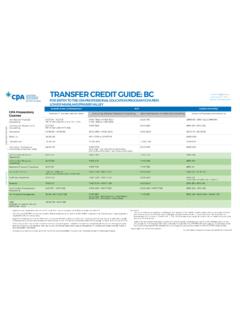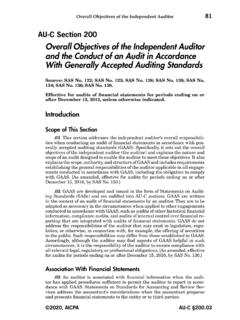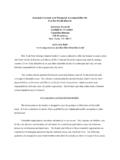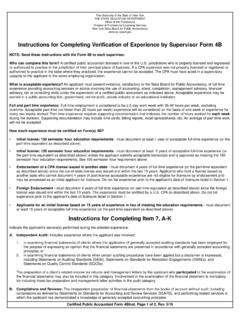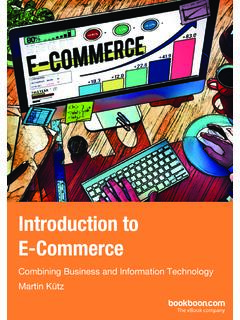Transcription of PREAMBLE TO THE CPA CODE OF PROFESSIONAL CONDUCT
1 CPABC CODE OF PROFESSIONAL CONDUCT August 2022 1 TABLE OF CONTENTS PREAMBLE TO THE CPA CODE OF PROFESSIONAL CONDUCT .. 4 Application of the CPA Code .. 4 Introduction .. 4 Characteristics of a profession .. 4 Responsibility for compliance with the CPA Code .. 5 Fundamental principles governing CONDUCT .. 5 Personal character and ethical CONDUCT .. 7 Ethical conflict resolution .. 7 Principles governing the responsibilities of firms .. 8 DEFINITIONS .. 10 100 PROFESSIONAL GOVERNANCE .. 13 101 Compliance with governing legislation, bylaws, regulations and the CPA Code .. 13 102 Matters to be reported to 15 103 False or misleading applications .. 18 104 Requirement to co-operate .. 19 105 Hindrance, inappropriate influence and intimidation .. 20 200 PUBLIC 21 201 Maintenance of the good reputation of the profession.
2 21 202 Integrity and due care and Objectivity .. 23 203 PROFESSIONAL competence .. 26 204 Independence .. 27 Definitions .. 27 Transitional provisions .. 35 Assurance and specified auditing procedures engagements .. 36 Compliance with Rule .. 36 Identification of threats and safeguards .. 36 Guidance Rules to .. 36 1 Introduction .. 36 17 The 38 24 Extent of application of requirement for independence for different types of engagements .. 39 27 Evaluating threats and 40 30 Threats to 41 36 Safeguards .. 42 42 Practitioners with small or owner-managed clients .. 44 43 Application of the framework .. 44 44 Rebuttable presumption not subject to audit procedures .. 45 45 Other specific threats .. 45 46 Provision of non-assurance services.
3 45 48 Contingent fees .. 46 49 Actual or threatened litigation .. 46 Overview of independence standard for assurance engagements - flowchart .. 47 Specific prohibitions, assurance and specified auditing procedures engagements .. 48 (1)-(6) Financial interests .. 48 (7)-(9) Reserved for future use (10)-(12) Loans and guarantees .. 53 CPABC CODE OF PROFESSIONAL CONDUCT August 2022 2 (13) Close business relationships .. 55 (14),(15) Family and personal relationships .. 57 (16),(17) Employment and other service relationships .. 59 (18),(19) Serving as an officer or director .. 62 (20) Long association of senior personnel .. 64 (21) Audit Committee prior approval of services .. 66 (22)-(24) Management and accounting functions .. 67 (25) Valuation services.
4 71 (26) Actuarial services .. 73 (27) Internal audit 74 (28) Information technology system services .. 76 (29) Litigation support services .. 78 (30),(31) Legal services .. 80 (32) Human resource services .. 82 (3 3) Corporate finance services .. 83 (34) Tax 85 (35) Previously provided non-assurance services .. 89 (36),(37) Fees .. 91 (3 8) Evaluation or compensation .. 95 (39) Gifts and hospitality .. 96 (40) Client mergers and acquisitions .. 97 Documentation .. 99 Breach of a Members must disclose prohibited interests and relationships .. 105 Firms to ensure compliance .. 106 Independence: Insolvency 107 Disclosure of impaired independence .. 109 Reserved for future use Audits under elections legislation .. 111 205 False or misleading documents or oral representations.
5 114 206 Compliance with PROFESSIONAL standards .. 115 207 Unauthorized benefits .. 119 208 Confidentiality of information .. 120 209 Borrowing from clients .. 122 210 Conflicts of interest .. 124 Guidance Rule 210 .. 125 A Glossary of terms .. 125 B Identifying conflicts of interest .. 126 C Commonly accepted practice .. 127 D Management of conflicts of interest .. 127 E Conflicts of interest encountered by PROFESSIONAL service area .. 128 F Process for dealing with conflicts of interest .. 133 G Documentation .. 140 H Other conflict of interest considerations .. 140 Conflict of interest management decision chart .. 141 211 Duty to report breach of the CPA Code .. 142 212 Handling trust funds and property of others .. 144 213 Unlawful activity .. 146 214 Fee quotations and billings.
6 147 215 Contingent fees .. 148 216 Commission and other compensation arrangements .. 150 217 Advertising, Solicitations and Endorsements .. 154 218 Retention of documentation and working papers .. 159 CPABC CODE OF PROFESSIONAL CONDUCT August 2022 3 300 PROFESSIONAL COLLEAGUES .. 161 301 Reserved for future use 302 Communication with predecessor .. 162 303 Provision of client information .. 164 304 Joint engagements .. 166 305 Communication of special engagements to incumbent .. 167 306 Responsibilities owed to an incumbent .. 168 400 PUBLIC ACCOUNTING PRACTICES .. 169 401 Practice names .. 169 402 Use of descriptive 171 403 Association with .. 172 404 Access to members practising public accounting .. 173 405 Office by representation .. 174 406 Responsibility for a non-registrant.
7 175 407 Reserved for future use 408 Association with non-registrant in public practice .. 177 409 Practice of public accounting in corporate form .. 178 410 Suspended or former members and public practice .. 179 500 FIRMS .. 180 501 Policies and procedures for compliance with PROFESSIONAL standards .. 180 502 Policies and procedures for CONDUCT of a practice .. 181 503 Association with .. 182 [600 to 900 for provincial/territorial use as necessary] CPABC CODE OF PROFESSIONAL CONDUCT August 2022 4 PREAMBLE TO THE CPA CODE OF PROFESSIONAL CONDUCT Application of the Code This CPA Code of PROFESSIONAL CONDUCT (the CPA Code ) sets out general and specific duties for sound and fair financial and management reporting and business practices owed by all members, students or firms to clients, employers and the public generally as well as to the profession.
8 The CPA Code applies to all members, students and firms, irrespective of the type of PROFESSIONAL services being provided. Throughout the CPA Code, the term registrant is used to refer inclusively to a member, firm or student, and where necessary, explicit references to a member, firm or student are used in place of the term registrant. Registrants not engaged in the practice of public accounting must observe the CPA Code unless there is a specific exception made in a particular provision or the wording of any provision makes it clear that it relates specifically to the practice of public accounting. The term PROFESSIONAL services applies to all registrants and is not restricted only to those who are engaged in the practice of public accounting. It includes those of a registrant s activities, whether undertaken for remuneration or not, where clients, employers, the public or PROFESSIONAL colleagues are entitled to rely on licensure or registration with CPABC as giving the registrant particular competence and requiring due care, integrity and an objective state of mind.
9 The CPA Code also applies, with the necessary modifications, to every registrant acting in respect of a matter of personal concern and to the exercise, by the registrant, of any other activity, in particular, a job, a function, an office or the operation of an enterprise. The CPA Code is to be read and applied in light of this PREAMBLE , the Act, the bylaws of CPABC, and the definitions included in the CPA Code, the Act and the bylaws of CPABC. Rules impose an obligation on registrants; accordingly, compliance with the Rules is mandatory. Where Guidance is provided, it is intended to assist in the understanding and application of the related Rule. Introduction This PREAMBLE to the CPA Code sets out the philosophy that underlies the code governing the Chartered PROFESSIONAL Accountant's responsibilities to those to whom PROFESSIONAL services are provided, to the public generally and to colleagues, in respect of: characteristics of a profession; responsibility for compliance with the CPA Code; fundamental principles governing CONDUCT ; personal character and ethical CONDUCT ; ethical conflict resolution; and principles governing the responsibilities of firms.
10 The CPA Code, comprehensive in its scope, practical in application and addressing high ethical standards, serves not only as a guide to the profession itself but as a source of assurance of the profession's concern to serve the public interest. It is a hallmark of a profession that there is a voluntary assumption, by those who comprise it -- the members of the profession -- of ethical principles which are aimed, first and foremost, at serving the public interest and, second, at achieving orderly and courteous CONDUCT within the profession. It is to these purposes that CPABC s Code is directed. Characteristics of a profession The CPA Code presumes the existence of a profession. Since the word "profession" has lost some of its earlier precision, through widespread application, it is worthwhile reviewing the characteristics which mark a calling as PROFESSIONAL in the traditional sense.
